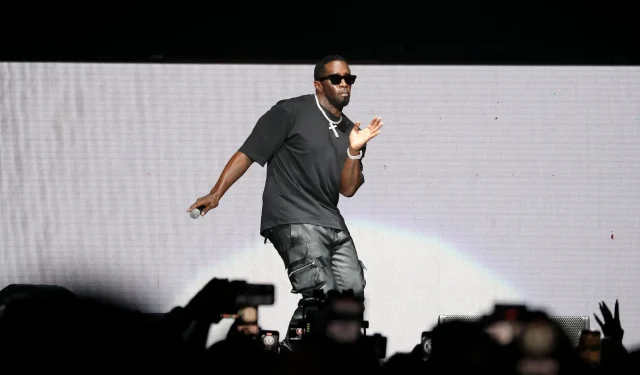
Earlier this week, federal agents apprehended Sean “Diddy” Combs at the Park Hyatt Hotel on West 57th Street in Manhattan, New York City. According to a comprehensive 14-page grand jury indictment, he faces serious charges including racketeering, sex trafficking through coercion, and transportation for the purpose of engaging in prostitution.
On Tuesday, September 17, the 54-year-old music mogul pleaded “not guilty” in a court hearing but was denied bail as the prosecution labeled him a “serious flight risk.” In light of his arrest, Diddy’s expansive back tattoo, which he had inked in June 2017, has attracted significant attention. The intricate black-and-grey design spans his entire backside and portrays two mythological figures.
While Diddy has never officially disclosed the meaning behind his tattoo, internet investigators theorize that it represents the Haitian Vodou spirit Ezili Dantor.
As detailed by Lithub, Ezili Dantor embodies womanhood, love, sexuality, prosperity, pleasure, motherhood, creativity, and fertility. She is often regarded as a guardian of women and children, prompting discussions on social media about the implications of Diddy possessing such a tattoo.
Many see the tattoo as particularly ironic, given his allegedly troubling history of sexual abuse, assault, and trafficking. Here are some comments on X regarding this subject:
“Every once in a while, I think about this tweet, especially after learning who Ezili Dantor is. And I just can’t help but to wonder what was going through his mind when he got her tattooed on his body… knowing what he does behind the scenes,” a user remarked.
“Sean Combs’ back tattoo is of Haitian Vodou Goddess Ezili Dantor, also known as ‘The Black Madonna.’ According to her followers, she is a protector of women and children. So why would a predator permanently ink himself with such a goddess? Symbolism will be his undoing,” another user tweeted.
“I had no idea Diddy had this??!! What an idiot!! Ezili Dantor HATES r**ists, protects women and children, runs revolutions, and well-lit makes r**ists hang themselves! Diddy played in the face of the WRONG ONE,” another commented.
Others speculated on the motivations behind Diddy choosing to get Ezili Dantor inked on his back.
“I genuinely wonder if he got that done thinking it would absolve him of his ‘sins,’” wrote one netizen.
“Ezili don’t play so idk why he would do those terrible things and get mama Dantor tatted on him,” commented another.
“Ezili Dantor? To ‘absolve his sins’ (heinous crimes) of abusing women? Good luck with that playa!” wrote another user.
Meanwhile, many are predicting that Sean Combs’ incarceration will be evident.
“The dumbest n***a ever. Ezili Dantor is a protector of women and children. You’re going under the jail,” an individual wrote.
“Diddy will be popular in prison,” wrote another.
All You Need to Know About Diddy’s Tattoo and Its Symbolism
In mid-2017, Sean Combs shared an image of his elaborate back tattoo on Instagram. The now-deleted post included the caption, “I got the front And She got my BACK,” and tagged celebrity tattoo artist Nikko Hurtado. The tattoo displayed a lifelike depiction of a woman with a child, complete with intricate detailing.
After the photo of his back tattoo became viral, many speculated that it depicted Ezili Dantor, a principal Ioa (or Lwa) within the Haitian Vodou religion, often seen as a representation of motherhood, womanhood, discipline, guardian, and protector, according to Lithub.
“The beautiful femme queen, bull dyke, weeping willow, dagger mistress Ezili. Ezili refers to a group of lwa symbolizing divine forces of love, sexuality, prosperity, pleasure, motherhood, creativity, and fertility. She is also a guardian for ‘madivin’ and ‘masisi,’ which refer to transmasculine and transfeminine Haitians,” Lithub elaborates.
The site further notes that the spirit represents both mirrors and maps for queer love, imagination, and black feminism. Meanwhile, ‘Dantor’ is described as a “fierce protectress,” evoking strength and safeguarding.
“It remains a black feminist necessity to explicate, develop, and dwell in the demonic grounds of realities other than the secular Western empiricisms that deny black women’s importance in knowing, making, and transforming the world,” Lithub discusses.
Ezili Dantor, also known as Erzulie Danto, continues to be a prevalent figure not only in Haitian Vodou but also in Caribbean literature and anthropological studies.
According to Lwaandorder.com, Ezili, characterized by her fiery eyes and daggers, first emerged in the late 18th century during the Bwa Kayiman festival in northern Haiti, a pivotal event that spurred the Haitian Revolution. The site highlights Ezili as a figure of revenge, retribution, and sacrifice for the wronged.
She is often depicted as a loving mother or Rada Dantor alongside her child Ti-Jan Petro, who is seen as both her brother and lover. It’s also said that she carries her daughter Anaise in her arms.
Additionally, her crown is thought to symbolize her role as the Queen of the Dead/ancestors, while the number seven is significant to her. Diddy’s back tattoo has also been associated with the Black Madonna, a representation in the Catholic faith of the Blessed Virgin Mary holding infant Jesus.




Leave a Reply